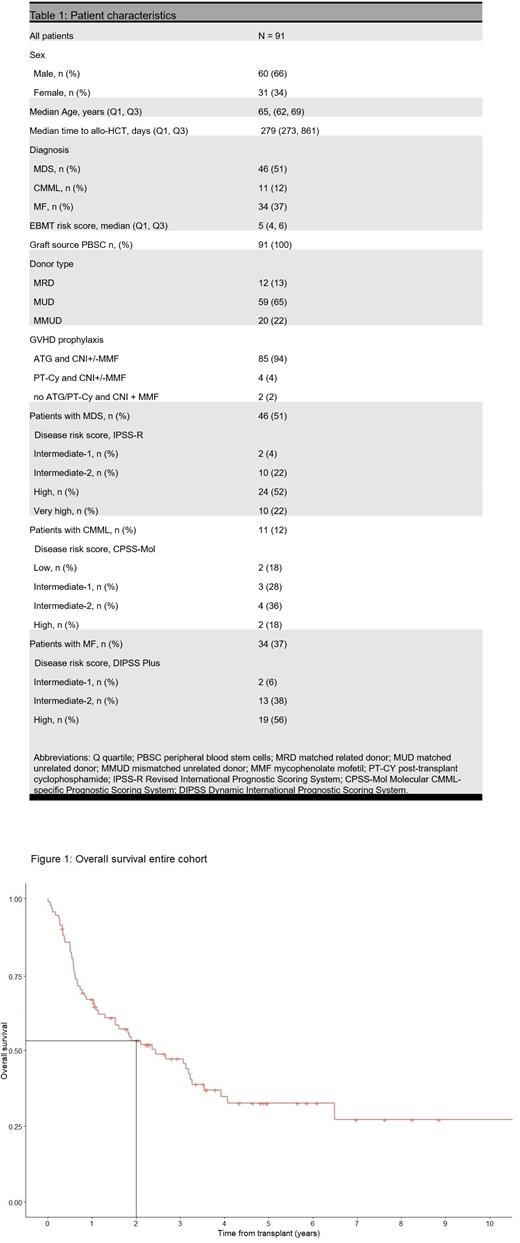Introduction
Allogeneic hematopoietic stem cell transplantation (alloHCT) is the only potential curative treatment for patients (pts) with high-risk myeloid malignancies. Despite advances in the supportive care over the past decades, alloHCT is still associated with significant toxicity, especially in the elderly population. The choice of an adequate conditioning regimen has become essential in order to prevent treatment-related morbidity and mortality. Since myeloablative conditioning (MAC) is mostly restricted to the younger population due to the high toxicity, reduced-intensity conditioning (RIC) provides an alternative solution. However, especially for pts with high-risk disease, a potential increase in the incidence of relapse must be taken into account. The advent of reduced-toxicity conditioning regimens (RTC), mostly based on treosulfan in combination with fludarabine, offers a balance between a favorable toxicity profile and a strong anti-neoplastic effect.
Considering the increasing rates of alloHCT among older pts in the past decades, finding the optimal conditioning regimen is still an unmet need for this collective.
The objective of this study is to analyze the outcome of pts aged ≥60 years who underwent alloHCT for myelodysplastic or myeloproliferative disease and received a treosulfan-based conditioning. In order to maximize the anti-leukemic effect of the conditioning in this population we chose the myeloablative dose of treosulfan of 14g/m2 daily.
Materials and methods
We retrospectively analyzed the outcome of adult pts ≥60 years with myelodysplastic syndrome (MDS), chronic myelomonocytic leukemia (CMML) or myelofibrosis (MF) who underwent their first allo-HCT from a matched or mismatched donor over a period of 10 years at the adult Bone Marrow Transplantation Unit of our institution. The conditioning consisted of a combination of treosulfan 14 g/m2/day on days -6 to -4, fludarabine, 30 mg/m2/day on days -6 to -2, alone or combined with 2 Gy TBI (day 0) for MDS and treosulfan, 14 g/m2/day on days -6 to -4, fludarabine, 30 mg/m2/day on days -6 to -3 for CMML and MF. Endpoints of this analysis were engraftment rate (together with time to engraftment), relapse-free survival (RFS), overall survival (OS), and non-relapse mortality (NRM). Continuous variables were illustrated as median values. NRM, RFS and OS for the whole cohort were analyzed with the Kaplan-Meier method and presented as survival functions.
Results
Between 01/2012 and 12/2022 91 consecutive elderly pts were eligible for this analysis. Patient and transplant characteristics are listed in Table 1. The median follow-up after allo-HCT was 3.12 years (4 months-10.5 years). Median age was 65 years, 76% (n = 69) of patients had an EBMT (European Society for Blood and Marrow Transplantation) risk score of ≥ 4. In 20 of 91 pts (22%) a 9/10 matched unrelated donor was selected, due to the lack of a more suitable donor. The standard graft versus host disease (GVHD) prophylaxis was a combination of calcineurin inhibitors (CNI) +/- mycophenolate mofetil and Anti-T-lymphocyte globulin (ATG) (n= 85, 94%). Neutrophil engraftment was achieved in 98% (n= 89) of pts. The median time to engraftment was 13 days (12, 15). Fourteen of 91 pts (15%) developed severe (grade III-IV) acute GVHD, and 44% (n= 40) had chronic GVHD of any grade. Considering early toxicity, 2 patients of 91 (2%) died before day +30 after alloHCT due to transplant-related toxicity, overall 6 of 91 (7%) in the first 100 days after alloHCT. The 2-year OS was 55% (95% CI, 44.7-.66.2) (Figure 1) and RFS was 48.5% (95% CI, 38.9-60.5). The 2-year NRM was 37% (95% CI, 33.5-39.5). No significant differences have been observed in the outcome of the different disease entities. Main causes of death were infections (n= 15, 32%), GVHD (n=13, 27.7%) and disease relapse (n= 13, 27.7%).
Conclusions
Our retrospective analysis suggests that a treosulfan-based RTC with myeloablative potential in an elderly and frail population of pts with high-risk myeloid diseases is feasible, with an excellent engraftment rate and a limited early toxicity, and promotes disease control. We report a 2-year NRM of 37%, which was partially due to severe GvHD in a cohort of pts with a relatively high-proportion of mismatched donors (20%). The role of post-transplant cyclophosphamide as backbone of the GvHD prophylaxis of RTC regimes should be further evaluated, in prospective trials.
Disclosures
Dohner:AbbVie: Consultancy, Research Funding; Agios: Consultancy, Research Funding; Amgen: Consultancy, Research Funding; Astellas: Consultancy, Research Funding; AstraZeneca: Consultancy; Berlin-Chemie: Consultancy; Bristol Myers Squibb: Consultancy, Research Funding; Celgene: Consultancy; GEMoaB: Consultancy; Gilead: Consultancy; Janssen: Consultancy; Jazz Pharmaceuticals: Consultancy, Research Funding; Novartis: Consultancy, Research Funding; Syndax: Consultancy; Kronos-Bio: Research Funding. Sala:Medac: Other: Support for meeting attendance; Novartis: Honoraria; Takeda: Consultancy; Jazz Pharmaceuticals: Consultancy, Honoraria, Other: Support for meeting attendance; Kite Gilead: Consultancy, Honoraria, Other: Support for meeting attendance; BMS: Consultancy, Honoraria.


